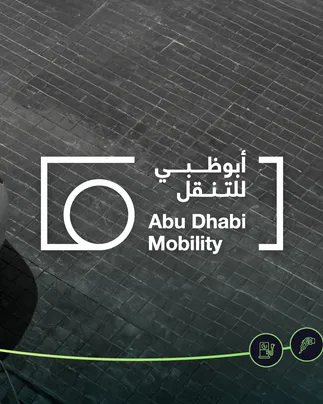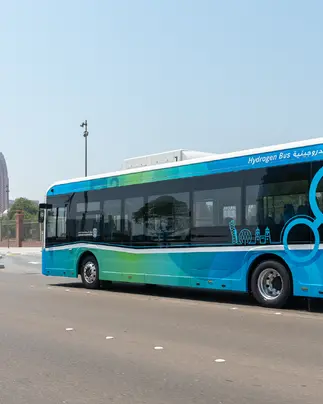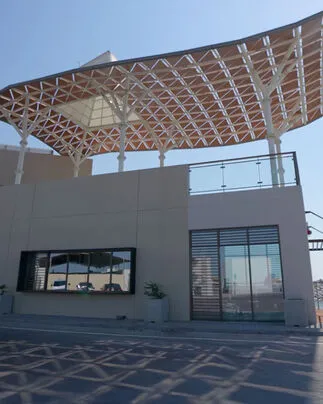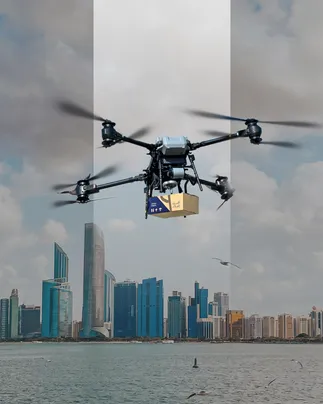The Integrated Transport Centre of the Department of Municipalities and Transport in Abu Dhabi, in collaboration with the General Command of Abu Dhabi Police and the strategic stakeholders, carried out a joint experiment to test the response towards emergency situations. The exercise represented a mock rescue experiment in the Sheikh Zayed Road tunnel, simulating a collision between a truck carrying flammable materials (violating the laws for the use of the tunnels) and a bus transporting passengers. The collision resulted in a fire, leading to several injuries and cases of suffocation as a result of fume inhalation in passengers using the tunnel. A number of government entities participated in the experiment consisting of the Abu Dhabi Civil Defence Authority, Abu Dhabi City Municipality, Abu Dhabi Centre for Waste Management, as well as private entities consisting of the Emirates General Transport and Services Company "Emirates Transport" and ST Engineering Electronics Ltd.
The Abu Dhabi Police commended the ITC’s efforts in the organization, coordination, and collaboration between the strategic stakeholders, which was evident in the implementation of the emergency plans in carrying out the mock-up experiment, while ensuring all prevention and safety requirements are met. Additionally, the emergency response teams were highly prepared and equipped which in turn reinforced the developmental security efforts that positively reflects the quality of police work according to the best international standards.
The ITC clarified that the experiment was executed within the framework of joint training on security and safety procedures, aiming to clarify these procedures and enhance integration and coordination between the relevant stakeholders in dealing with accidents and emergencies. It also intended to test the unified operational and coordination procedures to ensure the mutual readiness when dealing with these cases at the appropriate speed and efficiency, whether regarding response time or evacuation, performance evaluation, as well as the development of performance improvement plans.
The experiment aimed at clarifying the role of each party in dealing with emergency situations, in accordance with the applicable requirements in the Joint Accident Procedures Manual, and to determine the situations that require the transfer of leadership responsibility between the partners in managing the site of the accident, depending on the nature of the accident, the injuries and damages that may occur as a result. The experiment’s main objective was to ensure preserving lives and property while minimizing potential damage.
The ITC confirmed that the mock experiment operation achieved its goals efficiently and effectively, commending the efforts of the participating strategic stakeholders for their quick and highly professional response in implementing the evacuation, ambulance operation, and assisting the injured and all who were present in the tunnel. The teams participating in the operation were able to evacuate the injured and all who were present in the tunnel, as well as control the fire and successfully complete the entire experiment.
Indicating all the while, the importance of the time factor in responding to the accident and the speed of closing the entrances to the tunnel before the number of vehicles increased inside it, which would jeopardize the rescue mission, and put people’s lives at risk. The ITC attributed the success of the operation and the reduction of response time to the effective coordination and communication between the strategic stakeholders and their full compliance with the applicable requirements in the Joint Accident Procedures Manual.
Furthermore, the ITC directed a number of tips and instructions for road users, including the need to pay attention to the traffic lights when approaching the tunnel entrances. The lights will change to red and then close the tunnel in cases of major accidents or emergencies as well as divert traffic to surface roads. The ITC also advised drivers to hasten in clearing the way for firefighting vehicles and teams, to facilitate the rescue process and has also instructed passenger to keep their vehicles’ windows closed in cases of fire inside the tunnel.
The Sheikh Zayed Road Tunnel is a main path on the island of Abu Dhabi, an approximate of 40,000 vehicles pass through it daily. It is one of the longest and safest traffic flow tunnels in the Middle East with a length of approximately 4.2 kilometres which significantly contributes to the reduction of traffic congestion in the city. It constitutes an ideal environment for transportation that is characterized with the highest standards of safety, eco-friendliness, and security through the use of the latest international technology in the field of monitoring, control, and management of the components of the tunnel.
It is worth noting that the Sheikh Zayed Road Tunnel and Street won the "Global Road Achievement Award" for the year 2014, organized by the International Road Federation "IRF," in recognition of the innovative construction engineering and excellence of the project on a global level.










